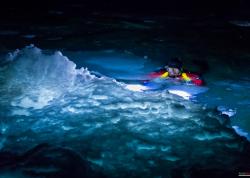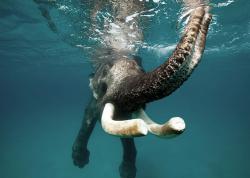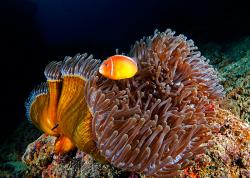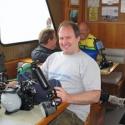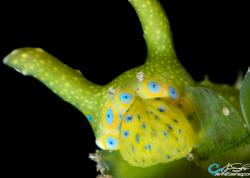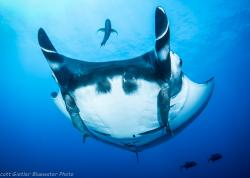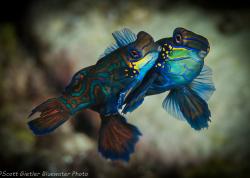Manta Ray Night Dive in Kona, Hawaii
In preparing for a week-long family trip to Kona, Hawaii I had done some research, and I heard that the Manta Ray night dive was a good dive. I was told that the Mantas were feeding at night, and were more approachable than during the day. But nothing could prepare me for the fact that we would indirectly be feeding the mantas, and how incredible that could be.

My first manta encounter of the trip while shore diving in Keauhou bay. Nikon D300, Tokina 10-17mm lens @12mm, F9, 1/250th, ISO 250
The Manta Dive at night
I arrived at the Kona Honu Divers boat with my dive gear, including my gloves, hood and 3mm suit, and my camera rig – twin strobes, Nikon D300, Sea & Sea housing, Sola 600 photo light, Tokina 10-17mm fisheye lens – all in my trusty AO Cooler bag. The boat crew got everything prepared on the boat while the customers waited comfortably on shore in lounge chairs. There was a mix of divers and snorkelers on the boat. Once the boat was ready, Captain Frank, who has been working for the shop for over 6 years, gave a thorough briefing. Then he turned things over to our divemaster, Scott, who explained the dive.
There would be several other boats at the site, and the divers from all the boats will be in a large circle. Each dive boat will put uniquely colored dive lights on the tanks. Do not touch the mantas. No snorkels allowed for divers. Hold the dive lights pointing upward next to your head. The mantas will feed on the plankton the dive lights attract. Every diver will be given a strong dive light. Our DM would be taking video of the dive, which would be available for purchase after the following day.
Scott also told us about Frank the friendly eel that might swim through our equipment, and Charlie the friendly trumpetfish who would nuzzle up close against us. I was really looking forward to meeting Frank and Charlie!

Charlie, the friendly trumpetfish
Scientists believe there many be 2 species of manta rays, a “coastal” manta ray – normally about 12ft wide, like the ones will see tonight, that live in the same area their entire life, and a larger pelagic manta, 20-25ft wide, like the kind you might see in Bali or Socorro. You can read more here about the differences.

Manta ray flying by fast. F10, 1/100th, ISO 640
I was not excited about doing a dive with potentially 50 other divers. Normally I enjoy seeing only marine life underwater. But soon I was going to find out why this was a good thing.
After a 30 minute boat ride, we joined about 8 other boats at Garden Eel cove, near the Kona Airport. The airport area is a secured area, with a very rocky coastline, so you don’t normally see people trying to shore dive this spot. The manta rays used to show up at the Sheraton hotel south of Kona, with the first night dives happening around 1991. This happened until the hotel closed down, and the manta rays stopped appearing. Luckily for the dive operators and tourists, a dive shop called Eco-Adventures discovered that the mantas were feeding north of Kona near the airport, and the rest is history.

Once it was completely dark, we all got into the water. The snorkelers hung on to a large surfboard that had strong lights attached to it, pointing downwards. Our dive group swam underwater towards the underwater “ring” setup, where all divers would be in a giant circle on their knees for the entire dive. A circle of stones is setup so the divers are always at the same place. On the way to the circle, we watched a couple 12ft manta rays swim by. The game was on!

The number of manta rays grew from 4 to 20 over the next hour. They literally fed off the plankton that was attracted to your dive lights, which means you often had giant manta rays swooping down within a few inches of your head. It was totally amazing. They would swim in open-mouthed, they would do flips and acrobatics in front of you. Five minutes into the dive, I looked down, and Charlie the trumpetfish was nuzzled against me. He actually stayed too close to take photos of, perhaps he liked the shape of my camera rig. Trumpetfish are normally very skittish, and I could have done an entire dive with Charlie.
The circle of divers was very large and never felt crowded. Our group was near each other and I always saw the familiar “red glowsticks” on their tanks nearby. I was actually impressed how well the dive shops work together, and how well the divers behaved underwater.

Snorkelers at the top, and divers at the bottom. F10, 1/25th, ISO 500
As the dive progressed, things grew more chaotic – in a good way. More and more mantas appeared. They swam right over divers’ heads, raking in all the plankton they could find. Between the lights at the bottom, and the lights from the snorkelers, they had quite a bounty of plankton. A large school of fish positioned itself in the middle of the water column, trying to stay out of the way of the manta rays’ mouths. I was told if a manta takes in a fish, it will gently spit it out.

Manta and fish. The fish would scatter when the mantas swam through. F10, 1/100th, ISO 640
I had thought the dive was going to be 40 minutes long. When the DM signaled that it was time to swim back to the boat, I was pleased to see that we had been underwater for 60 minutes. I had taken 350 photos. One of my strobes had stopped working near the end of the dive. I could have stayed down all night. As I was about to get back on the boat, I saw several mantas swimming around a blue light hanging off our sister boat. This was a unique opportunity, and I swam over to them for 5 more minutes, taking photos of mantas “in the blue”.

Manta ray "in the blue". F7, 1/50th, ISO 640
Back on the boat, our DM Scott showed us on a tablet the names of the 20 mantas that appeared. You see, manta rays can be uniquely identified by the patterns on their belly, and Scott knew each one he saw that night. I was quite impressed! There are almost 200 mantas identified that live and stay in the Kona area. I later found out that sometimes no manta rays show up. It is rare, but it does happen. There is an alternate site to go to when this happens, south of Kona. Having over 20 show up was exceptional. I think the record is around 36 rays.

DM Scott's list of all the mantas that visited. We had 20 distinct mantas on this dive. All these mantas stay in the Kona area year-round.
Many thanks to Kona Honu Divers for running a very professional operation, with a well trained crew who was been with them for several years, which is always a good sign. If you dive with them, try to get out with Bo Pardue, he is an excellent underwater photographer who can help you get the best shots.
Manta Ray Underwater Photography Tips
Achieving focus underwater
I knew achieving focus on the manta rays at night would be a challenge. So I decided to pre-focus my rig and some rocks a few feet away, and then switch to “M” (manual) focus mode using the C/S/M switch of my Nikon D300. This meant there would be absolutely no focus delay when I pressed my shutter – very important since the manta rays will swoop in quickly. Using an ultrawide fisheye lens, and shooting at a larger depth of field meant that most of the shots would hopefully be in focus.
Shoot Wide
You want to use as wide of a lens as possible on this dive. My Tokina 10-17mm fisheye lens was perfect, and I often shot at the widest setting.
Strobe Positioning
Since I was shooting very wide, and there was plankton in the water, my strobes were far out, pulled back, and pointed outwards. Backscatter is always an issue when shooting at 10mm, if the strobes aren't out & back far enough. The exception was when I wanted to light up the inside of the manta’s mouth, I pulled my strobes closer in and pointed them forwards. This is the kind of dive where you are glad you have two strobes.
Depth of Field
To get more depth of field, I set fixed my aperture at f10 for the dive. Getting enough DOF was especially important since my focus was fixed throughout the dive.
Strobe recycle time
I wanted to shoot quickly, but I wasn’t using strobes that recycle almost instantly like Ikelite strobes. But I also wanted as much strobe power as possible. So I turned my strobes down ½ stop from full power, which helps the recycle time a lot, and also extends their life - and left them at the power for the duration of the dive.
Shutter for dive lights, ISO for exposure
Since my aperture and strobe power were fixed, I adjusted my ISO until the manta rays were getting exposed correctly. ISO 500 to ISO 640 generally gave decent exposures that were not over exposed. Once ISO was fixed, I adjusted the shutter speed until the dive lights in the background looked the way I wanted them too.
Composing the Manta Ray
I think it is important not to cut off parts of the manta ray. I was constantly using my zoom ring to get the proper composition while I was shooting through the viewfinder. My shots were taken at 10mm and 17mm, but more often at 11mm,12mm or 14mm.

Nice manta ray composition.

Open wide! I had to pull in my strobes and point them forward to light up the inside of the Manta's mouth.
Helpful info when planning your manta ray dive
Generally all ops go to the same spot. This is not a bad thing
Group size really doesn't matter, but ask if there are any bottom time limits
The place where you see the mantas is at 35ft depth. Water temps are usually 75-79.
Ask what the policy is, if no manta rays show up. Some shops may offer a free or discounted 2nd trip. This is not common, but it can happen. The manta rays are not seasonal, they are seen year round.
Dive ops will sometimes switch to a back-up site if the mantas are not appearing at Garden Eel Cove
Ask if you spend the entire night dive with the mantas, or if you swim around the dive site for half the dive. I'm not saying one is better than the other, but as an underwater photographer my personal preference is max manta time.
Surf / surge can sometimes be up in Jan/Feb, but in general the dive site and Kona in general is quite protected.
Any time is a good time to dive Kona. The months with fewer tourists (when I like to visit places) are non-holiday periods in April / May and Sept-Nov.
Read More Tips for Capturing Vibrant Manta Ray Photos
Further Reading
RECOMMENDED ARTICLES
SUPPORT THE UNDERWATER PHOTOGRAPHY GUIDE:
The Best Service & Prices on u/w Photo Gear
 Visit Bluewater Photo & Video for all your underwater photography and video gear. Click, or call the team at (310) 633-5052 for expert advice!
Visit Bluewater Photo & Video for all your underwater photography and video gear. Click, or call the team at (310) 633-5052 for expert advice!
The Best Pricing, Service & Expert Advice to Book your Dive Trips
 Bluewater Travel is your full-service scuba travel agency. Let our expert advisers plan and book your next dive vacation. Run by divers, for divers.
Bluewater Travel is your full-service scuba travel agency. Let our expert advisers plan and book your next dive vacation. Run by divers, for divers.




